Last Updated on January 5, 2024 by Greg Gillson
How often should you refill your bird feeder?
Reliably filled bird feeders will attract more birds.
To get birds coming to a new feeder, you’ll want to keep it full and not let it get completely empty.
However, once a feeder is established, you may want to let the feeders go empty completely every couple of weeks in order to clean the feeder.
There are also other reasons you may want to let your bird feeders empty every day–including the expense of bird seed!
Refill your feeders only once per day.
Birds are very skillful at finding food. Natural food sources come and go during the year, so birds are always looking for new supplies.
Birds are unlikely to starve if you stop feeding birds in your backyard. They’ll look elsewhere. In fact, chances are that the birds at your feeder are moving around your neighborhood and visiting other feeders on a regular circuit every day.
So that brings up the question: How many times a day should you feed wild birds?
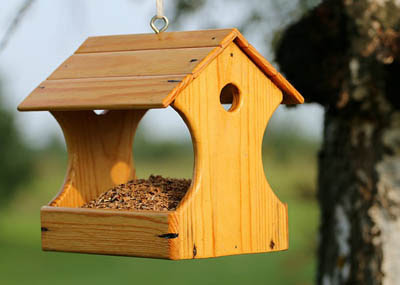 |
| Image by klimkin from Pixabay |
Reasons to keep your feeders full
As mentioned above, wild birds are good at finding food. This means that if your feeder is out of food, but your neighbor’s feeder is full, then birds may abandon your feeder for the one that is more reliable. Sure, some birds will return, but perhaps not the main bulk of the bird flock.
Keeping your feeder full is especially important in the beginning–when you are setting up a new bird feeder.
Feeding birds attract other birds looking for food. The sound of birds squabbling over food is sure to attract other birds from across the street or several homes over.
If your feeder is empty, then no squabbling noise and no new birds attracted to your feeder.
A large bird feeder full of seed may last several days before needing to be refilled. That certainly is easier than refilling a small feeder every morning, or even several times a day.
I recently noticed some very large seed blocks (8×8 inches) on some platform feeders that had many quail and doves eating from it. These would certainly last several days, and be harder for the birds to just swallow down quickly.
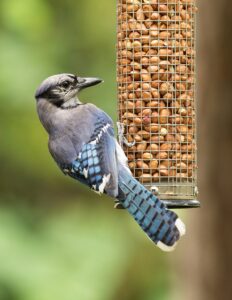
Reasons to allow your bird feeder to empty in a day
Wild birds don’t know where their next meal will come from, or when. Thus, when they do find food, they eat. And eat. They don’t stop. They eat until the food is gone or night falls, whichever comes first.
The more birds there are to compete with, the faster and more aggressively they eat. No wonder people say “Help! My birds are eating me out of house and home! My feeders go empty in a single day!”
Bigger is not always better. Some people purchase larger bird feeders to try to keep their feeders full all day. Often, though, this only encourages more birds to come for the banquet. And frequently, one species takes over the feeder.
It may be better to limit the bird’s diet and the number of birds at your feeder. You may decide to use a smaller feeder and only fill it once each day.
Typically, birds want to eat first thing at dawn. So the best time to fill empty feeders is before dawn or early morning. But I don’t want to get up that early to feed the birds. Do you?
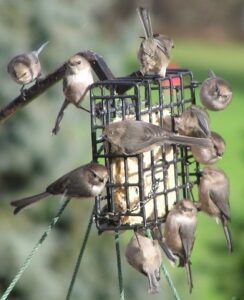
You could fill the feeders in the evening. Birds don’t eat from feeders at night. Then a full feeder would be ready for them first thing in the morning.
But this may invite unwanted feeder visitors. Skunks, raccoons, rats, and mice are frequent night-time bird feeder raiders.
Certain types of hanging feeders may keep out most of the unwanted pests from the bird feeders. But platform or tray feeders are usually easy pickings for unwanted four-legged visitors.
A final reason to allow your feeders to go empty periodically is cost. It can be expensive to feed an ever-growing number of birds in your backyard.
You may only want to fill your feeder once during the day. When it’s gone, well, that’s it until the next day. Such rationing is a very reasonable decision for those on a strict “bird seed budget.”
So what happens when your bird feeders go empty during the day?
Well, the birds don’t immediately leave. They drop to the ground and clean up any spilled morsels.
Of course, there are some sparrows, towhees, and doves that prefer to feed on the ground most of the time. But allowing a bird feeder to go empty during the day will cause finches and other feeder birds to descend to the ground.
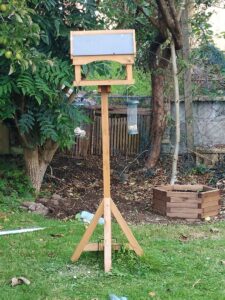
This daily cleanup may help keep a mess from forming on the ground under your feeder.. or at least slow the mess down.
It may keep squirrels and other unwanted pests away from your yard. Once these four-legged pests come to your feeder, it may not be long until they enter your home!
Once a feeder is empty it is easier to clean. Winter is a time of rain in many areas. Soggy bird seed grows mold and mildew and makes bird food unhealthy for the birds. Use an empty feeder as a chance to clean up the feeder, make any repairs, and clean up the ground around the feeder.
Are you worried that the birds will go elsewhere when your feeder runs out of food? Are you worried they might not return? There is a way to allow your bird feeders to go empty without causing the birds to abandon your backyard. You should have more than one feeder!
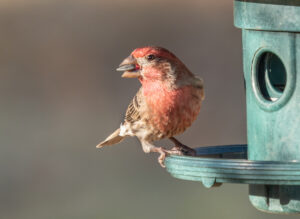
Multiple bird feeders: alternate the filling and cleaning of your feeders
The best way to allow your bird feeders to go empty without leaving your feathered friends without food is to have multiple feeders. Having more than one bird feeder is a good idea anyway.
Most birds have a favorite food. They will pick through their generic mixed bird seed like people pick through mixed nuts to find their favorite. Birds frequently toss undesirable seeds from the feeder.
The solution? Place only one type of bird food in each feeder. The birds will go to the feeder that has only the food they like!
That’s right. One tube feeder for black oil sunflower seed. One platform feeder with millet for doves. One suet feeder. One thistle sock with Niger seed. Perhaps a squirrel feeder with peanuts off to the side to try to keep these furry guys out of the bird feeders. There will be less waste with one food item per feeder.
Don’t forget to add water to your bird feeding station. Even if the bird feeders are empty birds will still come to the yard regularly to drink and bathe.
Having two feeders with the same type of food in them would allow one to go empty during the day while the other still has seeds. The birds never leave the yard to search for food elsewhere!
Those empty feeders should be spot cleaned before refilling each day. Feeders should be thoroughly cleaned every few weeks. Don’t just keep topping off the feeders all winter. Remove soggy or moldy foods and wash with a mild bleach solution.
Cleaning your feeders has many advantages.
Feeders can become clogged with non-edible chaff (all bird seed contains at least some stems and non-seed items). Most feeders have some nook or cranny that fills with old seed. Cleaning regularly and refilling your bird feeder with fresh, tastier food is more attractive to birds.
Some bird seeds have a limited shelf life, too. Last year’s bird seed may no longer be edible.
Purchasing “no mess” bird foods, such as hulled sunflowers, greatly reduces the mess and makes cleaning much less of a chore. Yes, it is more expensive per pound to buy. But since half of bird seed by weight is inedible hulls, you may find that it really isn’t so expensive after all. Of course, the birds can eat it faster because they don’t have to work as hard.
The most important reason to clean feeders is to keep bird diseases from spreading.
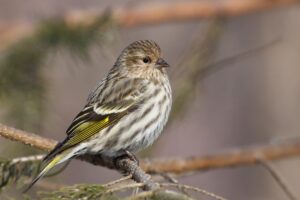
House Finches and Pine Siskins seem to spread communicable diseases when they are eating and defecating in their feeders. If you see signs of dumpy, sick birds, or dead birds in the yard, you may want to stop feeding until you can clean all the feeders. Then stop feeding entirely for 2 weeks to let the sickness run its course before refilling your feeders. Consider also temporarily removing the tray-type feeders where bird droppings and food can mix.
Wrapping Up
Whether or not you should put out bird feeders in your backyard depends on several factors. Here are some great reasons for providing food for the birds.
- Attract beautiful birds: Feeders can attract a diverse range of birds to your backyard, allowing you to observe and learn about different species.
- Provide supplemental food: During harsh weather or periods of scarce natural food sources, feeders can offer a vital source of nutrition for birds, especially during winter and spring.
- Enjoy nature close-up: Watching birds at feeders can be a relaxing and enjoyable activity, bringing nature closer to home and providing entertainment for yourself and your family.
- Support bird populations: Feeders can contribute to the overall well-being of bird populations in your area, especially in urban environments where natural food sources might be limited.
- Educational opportunities: Observing birds at feeders can be a great educational opportunity for children to learn about bird behavior, biology, and local ecosystems.
Frequently Asked Questions
Why do birds suddenly abandon feeders?
Birds suddenly abandoning your feeders can be a confusing and disappointing sight. There are several potential reasons for this abrupt desertion, so let’s explore some possibilities:
Changes in natural food sources:
- Seasonal bounty: When spring and summer arrive, natural food sources like insects, fruits, and berries become abundant. Birds might prioritize these fresh, nutrient-rich options over your feeder offerings.
- Fluctuations in abundance: Availability of natural food can fluctuate even within seasons. If an unexpected surge in insects or berries occurs nearby, birds might focus on that rather than your feeders.
Feeder-related issues:
- Empty feeders: Depleted feeders obviously won’t attract hungry birds. Ensure you refill them regularly, especially during cold weather or periods of high bird activity.
- Competition: Dominant species like jays or sparrows might monopolize the feeders, driving away smaller or weaker birds. Consider offering different feeder types and food options to cater to diverse birds.
- Hygiene issues: Dirty feeders can harbor bacteria and parasites, deterring birds. Practice regular cleaning with hot water and a mild disinfectant to ensure a safe feeding environment.
- Predator presence: Squirrels, cats, or other predators lurking near feeders can scare away birds, even if they haven’t been directly attacked. Consider squirrel-proof feeders, using deterrents, or relocating your feeders to a safer spot.
Why do birds drop so much food out of feeders?
The sight of discarded seeds around your bird feeders can be puzzling, leading us to wonder why birds waste so much food. However, there are several reasons behind this seemingly messy behavior, and it’s not necessarily due to carelessness! Here are some possible explanations:
Selective eating:
- Picking the best: Birds prefer certain seeds based on their nutritional value, taste, or ease of cracking. They might discard smaller, less desirable seeds or hulls after extracting the good stuff.
- Storing for later: Some birds, like jays and chickadees, cache seeds for later consumption or to feed their young. They might drop seeds while preparing them for storage or transporting them to their hiding places.
Competition and dominance:
- Dislodging rivals: Dominant birds like larger sparrows or jays might knock out seeds from feeders to chase away competitors or secure more access to the preferred options. These dislodged seeds might end up on the ground.
- Clumsy feeders: Inexperienced young birds or species new to feeders might struggle to hold onto seeds while feeding, accidentally dropping them in the process.
How do birds know there is food in a feeder?
Birds rely on a fascinating combination of senses and past experiences to locate food sources like your bird feeder, here’s how they figure it out:
Visual Cues:
- Sharp eyesight: Birds have exceptional vision, particularly for color and movement. They can easily spot brightly colored feeders against natural backdrops, especially feeders filled with contrasting seeds.
- Reflective surfaces: Shiny metal feeders or feeders with windows can catch sunlight and glint, attracting attention from afar.
- Learning by observation: Birds watch other birds, especially their own species or familiar flocks. If they see others visiting and feeding at your location, they’ll be more likely to investigate themselves.
Auditory Cues:
- Sounds of activity: Birds feeding at a feeder make noise while cracking seeds, fluttering their wings, and calling to each other. These sounds can travel distances and attract other birds seeking food.
- Memory of sounds: Birds remember locations associated with positive experiences like finding food. If they previously found your feeder, they’ll be more likely to recall the sounds and investigate again.
________________________________________________________________________________________________
Check out: 7 different types of bird feeders and the birds they attract



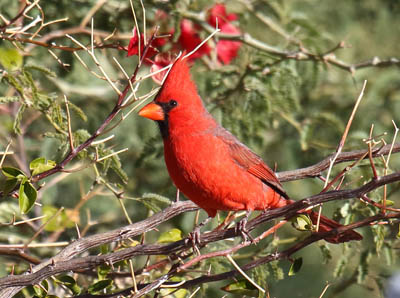
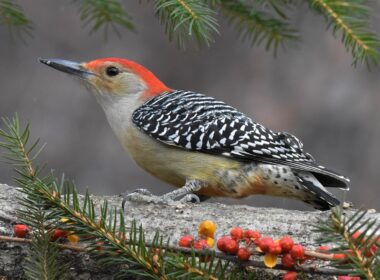
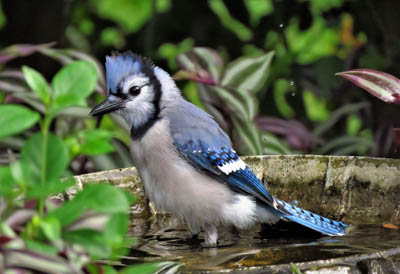
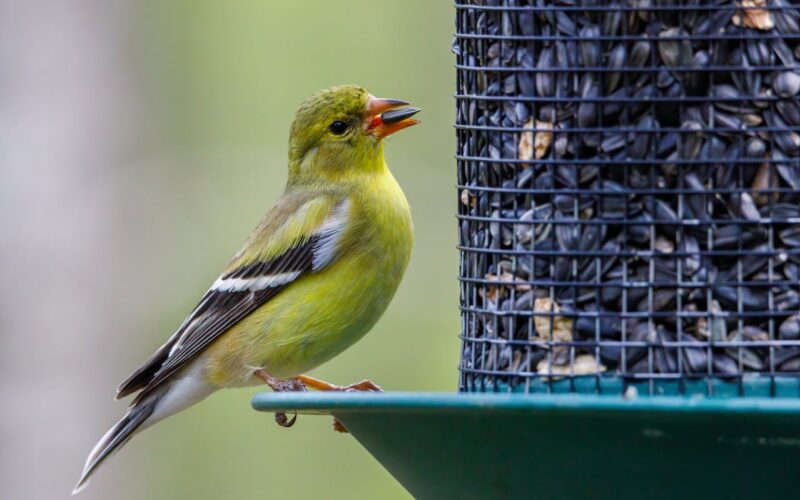

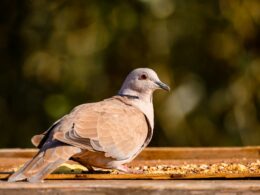
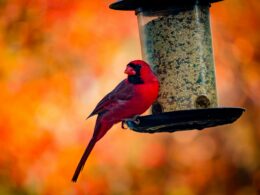
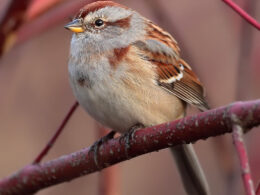
Very helpful!
Thank you!!
JSpecht you are very welcome!
Thanks…I have a feeder with wild bird seed blocks. It really attracted my favorites, chickadees. But gradually the sparrows started coming. I am going through 1 block every three days. Also, the chickadees aren't coming around anymore. I think I will call it quits. Getting too expensive also.
If you feed chickadees black oil sunflowers in a tube feeder you will really reduce the number of sparrows.
See also my article on feeding birds cheaply.
I also have tips on when to stop feeding birds that might give you ideas.
What happens when my feeders go empty for 2 days?
Birds are always on the lookout for food. They'll find your feeder again when you put food in it. The longer it is empty, though, the long it will take birds to find it again.
I live in Liverpool and at the back of my house is a disused railway line with trees and bushes all along so the amount of different breeds of birds is amazing. I have filled my bird feeder 3 times in one day but I'm now going to only fill it once a day as it's summer and there will be an abundance of insects.i buy fat balls that have sunflower seeds and nuts in them and every bird that visits seem to love them and I love feeding them.
Sounds like you have made a good decision on feeding your birds. And it sounds like a wonderful place you have for them!
Thank you for all of your good ideas. I'm going to try the individual bird feeders on hopes that I will attract different varieties of birds.
I'd be interested in knowing if you see any immediate difference.
Very helpful. Thank you
Thanks!
I put food out every day and do you have to wear gloves.. and also I only rinse with it water
Your point about having a few bird feeders is excellent. I learnt this over time here in Ireland. I clean the feeders that are out each day and while they are drying I use the other feeders. I find I usually have to clean them every day as if it rains the wet seed clogs the feeding portals. It's a wonderful hobby and to do it properly it does take a bit of time for cleaning and refilling. But it is time well spent as these little beauties deserve some tasty treats. Your article is very informative. Thank you
Thank you for visiting from Ireland!
If I put black oil sunflower seeds in my tube feeder , as I have done since last June, goldfinches sit on it, won't let the chickadees near it, (and yes I have a nyger seed feeder)..they also just drop.all the sunflower seeds on the ground ..I don't know what to do,as I have had my chickadees for months
You might try adding a second feeder.
The goldfinches, as you say, sit on the feeder, as they can chew to split open the sunflower shell to get the seed inside. Then the inedible shells drop to the ground.
Chickadees cannot chew. So they take one seed at a time from the feeder, fly off, and hammer the seeds open with their stout bills on a branch.
I've been feeding the birds in drought-stricken NW New Mexico for 17 years. I regularly fill the feeders morning and night, and I'm mostly attracting pigeons, doves, and small birds. The drought is extremely bad now, and I must move from the area. I'm so torn over leaving the birds without food in this drought. There's sugar dishes out for the bees, hummingbird feeders, and wild bird seed. I throw black sunflower seeds on the ground for the pigeons. All this must stop in a month (I'm praying for rain) and I'm heartbroken. Could someone suggest ways I could do this less painfully for the birds, and for my own sanity? Someone suggested I feed less and less each day until I leave.
You can gradually feed less. Let your food and water go empty a couple of times before you leave to get them searching for new sources.
Even now your birds are probably visiting other feeders in your area. They are used to temporary food and water sources in the wild. So, they will probably do fine.
Excellent article! I learned so much more about bird feeding and will certainly try the multiple feeders! This year, I added a metal bird tray refilled with water every few days (its in the shade). I am from Canada and is wondering if it is safe for the birds to have tap water or better to use distilled water or rain water? Thanks for thr great article! 🙂
If it's safe for you, it's safe for the birds. Fresh rain water is what they normally drink (or dew off the plants)
8.6.2
My Friend:
I learned more about my bird friends reading
your articles than any other surce….always reasuring, always immediately useful.
Here in 7,000 feet elevation Santa Fe, New Mexico my daily customers have rased their
families and attuned their lives to our reliable supply of birdseed (usually Wagners).
After the 40-60 bird flocks of Blue jays and Scrub jays leave…my smaller varieties return
not wishingto, or ble to compete with their larger, noisier species. My large hanging feeder has discolored..Is there a useful life to
to these expensive tubes ?
My guess is that solar radiation is more intense at your high elevation. Then, yes, clear plastic will discolor and perhaps get brittle a bit faster in Sant Fe than down lower in the atmosphere.
Very very helpful thank you , I have a few things to do , change my tray to a hanging feeder , I bought a really good one on the UK but the birds didn’t take to it, maybe a will try again and be more patient
Enjoyed your articl very much and learned a lot about caring for bluebirds. This year, we put mealworms out in one of our feeders in early springs. The bluebirds came the next day and stayed to raise two families. We haven’t seen any for several weeks and just removed the old nest. Hope it wasn’t too early!
Oh, two broods? I'm jealous!
There are websites devoted to bluebird boxes. They will tell you when to clean out the boxes after the season is over.
I live In the PNW and feed wild birds. I have recently noticed a huge increase in eating at my bird feeders. It is now mid September. Should I anticipate this to continue through Fall and Winter? I also have a Frisbee filled with water. Once the rain starts can I remove this water source as their will be puddles?
Yes, all the young-of-the-year are coming to your feeder now. Soon northern birds will be joining them.
Fresh water is always welcome. It attracts birds year round.
Should I feel bad that the birds toss much of the seed to the ground this emptying my feeders quicker?
Sometimes birds do that looking for something they want better.
They can throw away seed that isn't good, too. So fresh seed is desirable.
Many birds prefer to feed on the ground, anyway. That's how quail, doves, and white-crowned sparrows get their seed at my feeder!